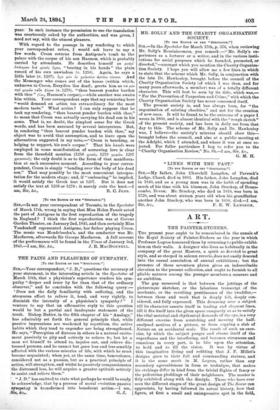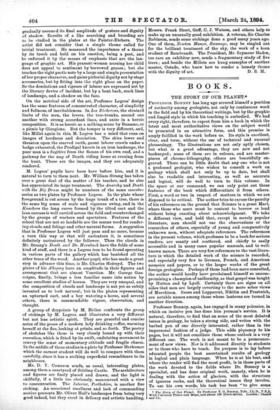ART.
THE PAINTER-ETCHERS.
THE present year ought to be remembered in the annals of the Royal Society of Painter-Etchers as the year in which Professor Legros honoured them by returning to public exhibi- tion on their walls. A designer who lives so habitually in the company of the great Masters, a spirit so devoted to great style, and so steeped in solemn reverie, does not easily descend into the casual association of . annual exhibitions ; but the presence of these seventeen plates gives an indescribable elevation to the present collection, and ought to furnish to all pliable natures among the younger members a measure and an ambition.
The gap measured is that between the jottings of the
picturesque sketcher, or the laborious transcript of the mechanic, or the revolting prettinesses of the twaddler,— between these and work that is deeply felt, deeply con- sidered, and fully expressed. This dreaming over a subject till its character asserts itself in leading and eloquent lines, till it fits itself into the given space compactly so as to satisfy the vital metrical and rhythmical demands of the eye, is a very different exercise from scratching and messing the half- analysed motives of a picture, or from copying a slab of Nature on an accidental scale. The result of such an exer- cise, by which the subject purges and cleans itself of the superfluous and the interfering. and becomes strenuous and conscious in every part, is to bite upon the attention, to hold and to fill the vision. It was by virtue of this imaginative fitting and refitting that J. F. Millet's designs grew to their full and commanding stature, and it is the same merit in M. Legros, rather than any secondary agreeableness in form or technique, that makes his etchings differ in kind from the trivial flights of fancy or the pedestrian ploddings of their neighbours. The master is fitly exhibited along with the disciple. Those who have ever seen the different stages of the great design of The Sower can appreciate, by having followed its actual history, how that figure, at first a small and unimpressive spot in the field,
gradually assumed its final amplitude of gesture and dignity of shadow. Results of a like searching and brooding are to be studied in the plates at the Painter-Etchers. The artist did not consider that a simple theme called for trivial treatment. He measured the importance of a theme by its touch and hold on his emotion, being a poet, and he enforced it by the means of emphasis that are the lan- guage of graphic art. His peasant-woman nursing her child does not appeal to sentiment by borrowed graces ; but she touches the right poetic note by a large and simple presentation of her proper character, and gains pictorial dignity not by stage accessories, but by fitting into the right place on the paper. So the desolations and rigours of labour are expressed not by the literary device of incident, but by a bent back, stark lines of landscape, and a shadow on the face.
On the metrical side of the art, Professor Legros' design has the same features of concentrated character, of simplicity and fullness, of inevitableness. In Les Biicherons, the strained limbs of the men, the levers, the tree-trunks, second one another with strong accordant lines, and unite in a heroic composition. It is as heroic as a milking-scene by Bassano, or a picnic by Giorgione. But the temper is very different, and, like Millet again in this, M. Legroe has a mind that runs on images of hardness and desolation. The skies lower and threaten -upon the starved earth, gaunt labour crawls under a hedge exhausted, the Prodigal kneels in an iron landscape, the poor man is a fugitive from the flames of his own roof, and a pathway for the nag of Death riding home at evening from the hunt. These are the images, and they are adequately rendered.
M. Legros' pupils have been here before him, and it is natural to turn to them next. Mr. William Strang has taken over a great deal of the matter of his teacher, and he also has appreciated its large treatment. The Anarchy and Death with the Big Drum might be numbers of the same macabre series as two plates by Professor Legros. In the plate whose foreground is cut across by the huge trunk of a tree, there is the same big sense of scale and vigorous swing, and in the Knackers the long curve formed by the tilted cart and the lean carcass is well carried across the field and counterchanged by the groups of workers and spectators. Features of the school that are not so laudable are the means used for render- ing clouds and foliage and other natural forms. A suggestion that in Professor Legros will just pass and no more, because a turn this way or that will caricature it, is sometimes definitely caricatured by the follower. Thus the clouds in Mr. Strang's Death and Dr. Hornbook have the folds of some kind of stuff, and there is a Legros tree to be found sprouting in various parts of the gallery which has banished all the other trees of the wood. Another pupil, who has made a great step in advance this time, is Mr. Charles Holroyd. The two plates of his Allegory have an amplitude in their figures and arrangement that are almost Venetian. Mr. George Gas- coigne, finally, brings a less familiar name into notice by some excellent studies o: horses. They are very unequal, and the composition of clouds and landscape is not yet so subtly invented as to look natural; but in the plates representing an upturned cart, and a boy watering a horse, and several others, there is commendable vigour, observation, and thought.
A group of drypoints by M. He]len confronts the group of etchings by M. Legros, and illustrates a very different but not less artistic spirit. They are graceful and concise notes of the poses of a modern lady drinking coffee, warming herself at the fire, looking at prints, and so forth. The poetry of sketches like these is very closely bound up with their execution, which is fitted by its swift, undulating movement to convey the sense of momentary attitude and fragile charm. In the middle of these studies is a plate by Professor Herkomer which the earnest student will do well to compare with them carefully, since it has a striking superficial resemblance to its neighbours.
Mr. D. Y. Cameron sends, as usual, interesting plates, among them a courtyard of Stirling Castle. The architecture and figures are finely placed and drawn, and the light is bkilfully, if a little too obviously, manceutvred with a view to concentration. The Interior, Perthshire, is another fine etching. An occasional smallness and lack of commanding motive prevents Mr. Oliver Hall's landscapes from being very good indeed, but they excel in delicacy and artistic handling. Messrs. Frank Short, Goff, C. J. Watson, and others help to make up an unusually good exhibition. A veteran, Sir Charles Robinson, sends some etchings done a good many years ago. One of them, Newton Manor, Swanage, may be singled out for the brilliant treatment of the sky, the work of a keen student of Rembrandt. The President, Mr. Seymour Haden, too rare an exhibitor now, sends a fragmentary study of five trees ; and beside the Millets are hung examples of another master, Ostade, who knew how to render a homely theme



































 Previous page
Previous page